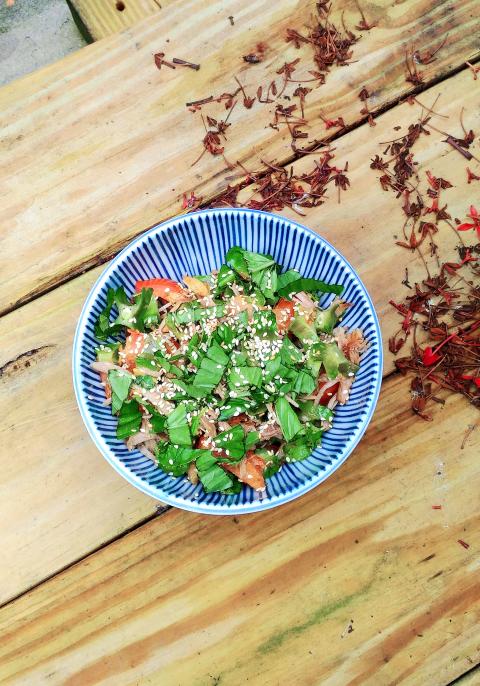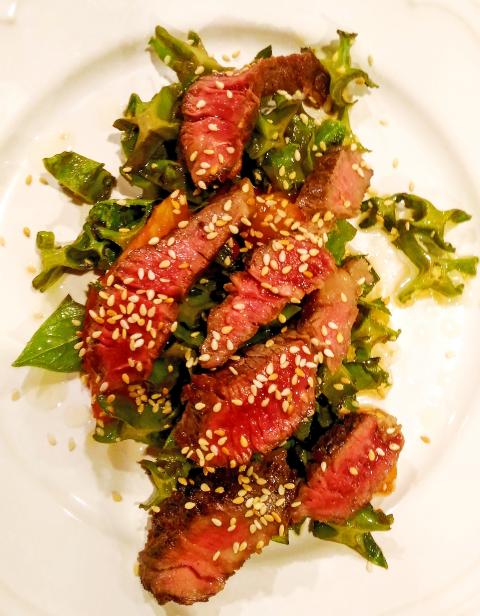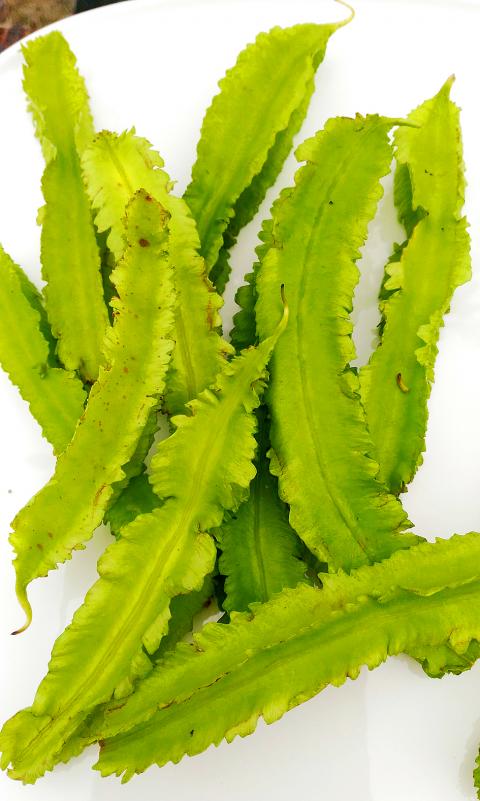The winged bean, also known as the Goa bean, four-angled bean, four-cornered bean, Manila bean and Mauritius bean, is one of those ideal foods, rich in nutrients, robust and able to handle harsh tropical environments, and easy to prepare. But it has been relegated to the fringes of culinary culture due to its non-conformist appearance and lack of marketing appeal. Winged beans look like plants you don’t want to mess with, but in fact are insanely easy to use, and taste great.
The scientific name for winged beans is Psophocarpus tetragonolobus, not something you are going to remember with ease, and it grows in abundance in tropical climates and features in the cuisine of many Southeast Asian countries. It is widely recognized for its tolerance of disease, growing well with little chemical aid even through Taiwan’s wet autumn weather with little or no help for the usual toxic arsenal of herbicides and pesticides that make many of the mainstream vegetables deeply suspect even after extensive washing.
To be perfectly honest, I had not seen winged beans until only a year or so ago among the diverse home grown crops of the Aboriginal ladies who sell their produce not far from our home outside the train station in Shoufeng (壽豐), Hualien County. I had asked them about the winged beans, which certainly looked interesting, but had never quite got round to buying them. This year, with its copious rain, most mainstream vegetables have become expensive, and more importantly, unappealing in both taste and appearance, so I was forced to branch out into the unfamiliar.

Photo: Ian Bartholomew
Now I can’t get enough of winged beans, inspired also by a recent visit to Thailand. The aim was to enjoy the fine dining opportunities provided by Bangkok and I was mortified when reviewing the trip that despite the considerable sums spent on highly recommended restaurants, the high point of my culinary adventures was a winged bean and noodle salad sold by an elderly lady at a shop with no sign or pricing, at a temporary market with seating provided by a bar that sold, as the price of a place to sit, the most execrable mojitos I have yet tasted (and I pride myself on my wide exposure to this beverage). It had noodles, a local salted fish, a spicy Thai dressing, and a sprinkling of winged beans, which provided a lovely crunch to the cold noodles. The crunch stuck and when I got back home, I was delighted to discover that winged beans are now one of the main vegetables offered at the local market.
The first thing that should be noted is that it is not just the bean that can be eaten. The whole plant of Psophocarpus tetragonolobus can be eaten, from leaves, to stems and even the roots. Studies have highlighted the fact that this is a vastly under utilized crop, so it is time to make a difference.
Starting with the bean, this can be eaten raw and simply thrown into a salad, providing a nice crunchy texture without much flavor. It’s rather fibrous texture means that it absorbs flavors well without getting too soggy, making it ideal for spicy dressings. It is the foundation of the Thai dish Yum Tua Phu. It is also used in Malay and Indian cooking, in the former case often cooked with belacan (a heavenly, or utterly vile, — depending on where you were brought up — smelling shrimp paste that is the fried gorgonzola of Southeast Asian cuisine) or curry in the latter.

Photo: Ian Bartholomew
Personally, while its flavor as a raw salad ingredient is perfectly acceptable, heating it slightly with oil softens the flavor without harming the nice crisp texture. It is important not to over spice, and the winged bean can easily become lost in too complex a mixture, or become flaccid and unappetizing if over cooked, the main issue with a regular stirfry preparation.
These relatively cheap and now readily available vegetables are exceptionally nutritious. The fresh, young bean pods are one of the finest sources of folates and are also rich in vitamin C, various B complex vitamins such as thiamin, pyridoxine (vitamin B-6), niacin and riboflavin. They are also great as a source of dietry fiber.
So there is really nothing bad to say about winged beans. What needs to happen is that they should feature more prominently on your menu.

Photo: Ian Bartholomew
Warm Winged Bean Salad
Recipe (Serves 4 as a side dish)
This is a warm salad rather than a stir fry and, if you prefer, it can easily be assembled raw, totally without the aid of a hob. My own preference is that a slight warming of the oil — to infuse the garlic and chili — and a slight softening of the winged beans (which also removes a rather assertive raw veg taste, pleasant to some but not to others), makes the dish come together more harmoniously.
This dish does not make any claims to extreme originality, as it is my own version of the Central Thai dish Yum Tua Phu, which also includes coconut, dried shrimp, tamarind and palm sugar. In this dish it is the peanut oil and sesame seeds that take center stage, so I would advise using an artisanal cold pressed peanut oil and make sure that the wok temperature is kept to a minimum, just enough to warm things up but never to really brown the contents.
Ingredients
300 g winged beans
3 tbsp peanut oil, preferably cold pressed
5 cloves garlic, minced
2 small chilies (ghost peppers are my current favorite for this dish)
1 tbsp soy
1 tsp fish sauce
1 tbsp sugar
handful of peanuts, crushed
handful of fried shallots
1 tbsp white sesame seeds
bunch of sweet basil
salt and white pepper
Directions
1. Cut the wing beans into small sections.
2. Mince garlic. De-seed the chilies unless you prefer plenty of fire on the tongue.
3. Heat a wok or saute pan over medium heat and add peanut oil. Add minced garlic and chili and fry until fragrant, about 30 seconds. The oil should almost foam up and a rich fragrance should emanate from the pan.
4. Throw in the chopped winged beans and stir until well coated.
5. Add the tomatoes and stir until just beginning to soften and release liquid.
6. Reduce to low heat. Add sugar, soy and fish sauce. Mix again until well coated with the dressing.
7. Remove from heat. Add the sweet basil, crushed peanuts and season with salt and white pepper.
8. Serve warm or at room temperature with white rice.
Ian Bartholomew runs Ian’s Table, a small guesthouse in Hualien. He has lived in Taiwan for many years writing about the food scene and has decided that until you look at farming, you know nothing about the food you eat. He can be contacted at Hualien202@gmail.com.

May 11 to May 18 The original Taichung Railway Station was long thought to have been completely razed. Opening on May 15, 1905, the one-story wooden structure soon outgrew its purpose and was replaced in 1917 by a grandiose, Western-style station. During construction on the third-generation station in 2017, workers discovered the service pit for the original station’s locomotive depot. A year later, a small wooden building on site was determined by historians to be the first stationmaster’s office, built around 1908. With these findings, the Taichung Railway Station Cultural Park now boasts that it has

The latest Formosa poll released at the end of last month shows confidence in President William Lai (賴清德) plunged 8.1 percent, while satisfaction with the Lai administration fared worse with a drop of 8.5 percent. Those lacking confidence in Lai jumped by 6 percent and dissatisfaction in his administration spiked up 6.7 percent. Confidence in Lai is still strong at 48.6 percent, compared to 43 percent lacking confidence — but this is his worst result overall since he took office. For the first time, dissatisfaction with his administration surpassed satisfaction, 47.3 to 47.1 percent. Though statistically a tie, for most

Six weeks before I embarked on a research mission in Kyoto, I was sitting alone at a bar counter in Melbourne. Next to me, a woman was bragging loudly to a friend: She, too, was heading to Kyoto, I quickly discerned. Except her trip was in four months. And she’d just pulled an all-nighter booking restaurant reservations. As I snooped on the conversation, I broke out in a sweat, panicking because I’d yet to secure a single table. Then I remembered: Eating well in Japan is absolutely not something to lose sleep over. It’s true that the best-known institutions book up faster

In February of this year the Taipei Times reported on the visit of Lienchiang County Commissioner Wang Chung-ming (王忠銘) of the Chinese Nationalist Party (KMT) and a delegation to a lantern festival in Fuzhou’s Mawei District in Fujian Province. “Today, Mawei and Matsu jointly marked the lantern festival,” Wang was quoted as saying, adding that both sides “being of one people,” is a cause for joy. Wang was passing around a common claim of officials of the People’s Republic of China (PRC) and the PRC’s allies and supporters in Taiwan — KMT and the Taiwan People’s Party — and elsewhere: Taiwan and